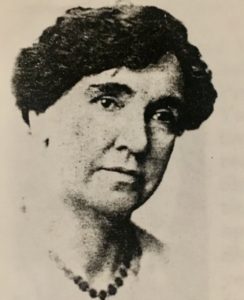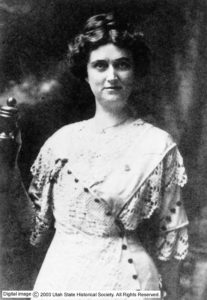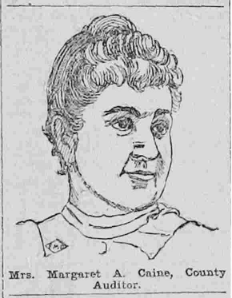UTAH WOMEN’S HISTORY / Explore the History / Utah Counties / Salt Lake

Salt Lake County
Key Players
Dr. Jane Skolfield

Dr. Jane Skolfield, Utah State Historical Society.
Dr. Jane Skolfield was born on a farm at Wilson Lake in Weber County. After marrying and divorcing early in life, she graduated from Brigham Young Academy in 1895. She then attended university in Chicago and returned to train teachers and teach kindergarten at Brigham Young Academy in 1897. After remarrying, Dr. Skolfield moved to Denver where she had four children while training to be a doctor. She moved to Salt Lake City after graduating medical school in 1907 and began working at Holy Cross Hospital and using her teaching experience to train nurses. She delivered many babies, took in unwed mothers, and helped facilitate adoptions for mothers that were in need.
Dr. Skolfield was elected to the legislature in 1912 and sponsored bills during her term in office pertaining to education and a minimum wage for women and minors. In 1917, she was elected as a delegate to the national suffrage convention in Washington, D.C. Dr. Skofield was a member and leader in many women’s clubs throughout Salt Lake City, including the Utah Women’s Press Club, and she helped raise money to have a bust of Utah’s leading suffragist Emmeline B. Wells made and displayed in the Utah State Capitol in 1928.
Lily Clayton Wolstenholme

Lily Clayton Wolstenholme, courtesy of Daniel A. Wolstenholme, Jr.
Lily Clayton Wolstenholme was born in 1863 while her parents were migrating across the plains. She was elected to Utah’s House of Representatives as a Progressive representative in 1914. Like many politically active women at the time, Lily supported both prohibition and women’s suffrage. During her time in the legislature, she wrote the Wolstenholme Bill which passed unanimously in the house in 1915 to increase punishments for selling or drinking alcohol. With this bill, Utah became one of the states that ratified prohibition prior to federal legislation on the matter.
After her service in the legislature, Lily remained active in Utah politics and continued to promote the work of women. In 1915 she attended the national suffrage convention in Washington, D.C., spoke in favor of suffrage to the national Democratic committee, and met with President Wilson to urge him to support a constitutional amendment for women’s suffrage.
In 1916, Lily was elected president of the Utah chapter of the National Council of Women Voters. As president, she worked to educate women about policy so they could effectively promote legislation that would improve the situation of women. Lily helped organize a suffrage convention in Utah with national suffrage leaders in 1917 and spoke about suffrage and women’s rights across the country and the globe, traveling as far away as Australia.
Elizabeth A. Hayward

Elizabeth A. Hayward, courtesy of the Wessman family.
In 1908, Elizabeth A.Hayward was sent as a Utah delegate to the National Democratic Convention in Colorado, which kick-started a political career for this woman who changed Utah’s and the nation’s history. That same year, Hayward and Lucy Clark attended the Buffalo, New York convention of the National American Woman Suffrage Association (NAWSA) by special invitation from national suffrage leaders.
Elizabeth was elected to the Utah House of Representatives in 1914 to represent Salt Lake County. She introduced a bill to raise the minimum age for workers to 16 years old and shorten women’s work day to 8 hours. Elizabeth was later elected as a state senator and became the first woman to preside over the Utah Senate while the senate leader took the floor to participate in a debate on February 27, 1919. Hayward also worked for national women’s suffrage while she served in state government, helping organize a Salt Lake suffrage convention attended by Alice Paul. In 1917, Hayward’s memorial urging President Wilson and Congress to pass a suffrage amendment was adopted by the Utah House of Representatives. Two years later, she introduced a resolution in a special session of the Utah Senate to ratify the constitutional amendment to enfranchise women nationally. This resolution passed unanimously, making Utah the 17th state to ratify the 19th Amendment. The next year, Hayward celebrated both the 50th anniversary of Utah women’s suffrage and the birth of women’s suffrage across the nation.
Anna T. Piercey

Anna T. Piercey in the March 1929 Relief Society Magazine.
Anna Thomas Piercey was born and raised in Salt Lake City. She graduated from Brigham Young Academy, the State University, and the Salt Lake Kindergarten Training School, becoming a teacher in the same city for five years. When her husband John died at the age of 39, Anna was left to raise their three children on her own. Anna was involved in many civic organizations in Salt Lake City, serving as assistant secretary to the Utah Council of Women, as secretary of the Salt Lake Women’s Democratic Club, and as president of the Woman’s Woodrow Wilson Club in Salt Lake.
Anna was elected to the State House of Representatives in 1918 on the Democratic ticket. The following year, when Utah’s legislature held a special session to ratify the 19th amendment to the federal constitution, Anna sat as chairperson of the house while the measure was voted upon. In a 1920 edition of The Woman Citizen, Anna explained her reasons for wanting to serve in the legislature. “My great desire in going to the legislature was to do something to better the conditions of women and children, especially women in industry. As I am a widow and a wage-earner, I felt like I understood conditions better than those who were not.” Anna served a total of three terms as a state representative, and authored the bill to establish an 8-hour work day for women which passed both the House and Senate. She also worked to pass a minimum wage for women, which passed in the House but was defeated in the Senate.
Anna served on the state board of the Daughters of Utah Pioneers, as chaplain of the Utah Order of Women Legislators, and volunteered with the American Red Cross and Travelers Aid Society. She passed away in Provo, Utah on February 22, 1953.
Dr. Grace Stratton Airey

Dr. Grace Stratton Airey. Photograph courtesy of the Utah State Historical Society.
Dr. Grace Stratton Airey was persistent in everything she did, so when she decided to try trout fishing in Utah’s Fish Lake, she donned her husband’s gear and took on the challenge. In fact, she was so determined to catch a trout that she jumped in the lake rather than letting go when a particularly large trout latched onto her line. This stubbornness and persistence was also apparent in her politics and activism for women. Dr. Airey moved to Utah and opened her medical practice of Osteopathy in 1905, and quickly became active in Utah politics and public health. She was a prominent woman in medical professions of Utah, and belonged to several Osteopath organizations and constantly worked to better the medical situations of women in Utah. She was elected to the Utah House of Representatives in 1917 and 1919, and both times served as the chair of the Committee on Public Health.
Dr. Airey’s terms overlapped with Elizabeth Hayward’s service, and they worked towards equal suffrage in the nation together. Dr. Airey was elected as a delegate to the Women’s Suffrage Convention in Colorado in 1916, and was a delegate to the Democratic Convention of Utah just a few months later. She helped establish several women’s Woodrow Wilson Clubs in Utah and participated in and helped organize women within the Democratic party. She also became the first woman to act as interim Speaker of the House in Utah (and probably the United States) in 1919, when she filled in while the Speaker was out.
Delora W. Blakely
Margaret A. Caine

Salt Lake Tribune, January 5, 1897.
Margaret Mitchell Caine was born in 1859 and raised in Salt Lake City. She was elected to the office of Salt Lake County Auditor in 1896. She served as the first female county official in Salt Lake County because 1896 was the first election where women citizens were allowed to run for public office in Utah. Margaret was very active in the Utah Silk Industry and had worked as a member of the commission for the Utah exhibition for the Columbian World’s Fair in 1893. When a traveling exhibition was needed for a Mid-Winter Fair in San Francisco of that same year, Margaret was in charge of the women’s exhibit on Utah silk. She was instrumental in the creation of the Utah Silk Commission, and traveled to London in 1899 to speak to the International Women’s Council on the subject of Utah silk production. Margaret passed away in November 1929.
Key Events
Coming soon.
Key Sites
City Hall (Council Hall)

City Hall (also called Council Hall) at its original location. Photograph courtesy of the Utah State Historical Society.
The Utah Territorial Legislature voted here on February 10, 1870 to extend voting rights to women, making Utah second only to Wyoming to grant women’s suffrage when the acting governor signed the bill on February 12. Two days later, school teacher Seraph Young and 24 other women cast their ballots in a municipal election in this same building. Since Wyoming did not hold an election until September 1870, these 25 women were the first women to vote in the modern nation.
Built in 1866, Council Hall originally stood at 120 E. 300 S. in Salt Lake City, but was moved to its present location at 300 N. State Street in 1961. In 1975 the building was designated a National Historic Landmark as a site of conflict between the U.S. government and Utah territorial government in the 1800s.
Salt Lake Tabernacle

Salt Lake Tabernacle c. 1870s. Photograph courtesy of the Utah State Historical Society.
Susan B. Anthony attended a dedicatory ceremony of the Salt Lake Tabernacle when she visited Utah with Elizabeth Cady Stanton in 1871 after Utah women gained suffrage. Both women spoke to large crowds in the Tabernacle, and the visit marked the beginning of a warm relationship between Anthony and Utah suffragists like Emmeline B. Wells. In May 1895, Anthony and the Reverend Dr. Anna Howard Shaw spoke in the Tabernacle as part of the Rocky Mountain Woman Suffrage Convention.
Council House

Council House in Salt Lake City. Photograph courtesy of the Utah State Historical Society.
Built in Salt Lake City in 1850, the Council House (or State House) was the first public building in Utah. For a time, it housed the offices of the Woman’s Exponent, a women-produced newspaper that ran for 40 years and voiced strong support of women’s suffrage. Meetings with local and national suffrage leaders were held here, where Emmeline B. Wells was the primary editor. Martha Hughes Cannon worked there as a typesetter to earn money for medical school. The building stood on the southwest corner of Main Street and South Temple in Salt Lake City until it was destroyed by fire in 1883.
Assembly Hall

Assembly Hall. Photograph courtesy of the Utah State Historical Society.
On January 10, 1889, Emily S. Richards and Margaret Caine organized a women’s meeting in Salt Lake City’s Assembly Hall to create the Utah Woman Suffrage Association, a local branch of Susan B. Anthony’s National Woman Suffrage Association. Because they had been stripped of their voting rights by Congressional legislation in 1887, many women came together across the territory to push for the inclusion of women’s suffrage in the state constitution when Utah became a state. The Utah Woman Suffrage Association eventually had chapters in 16 counties across Utah territory, and successfully lobbied Utah’s constitutional convention delegates to include an equal suffrage clause in the proposed state constitution which was ratified by Utah (male) voters in November 1895 and went into effect on January 4, 1896.
Social Hall

Social Hall. Photograph courtesy of the Utah State Historical Society.
The Social Hall was built in Salt Lake City in 1852 and served as a community building for plays, dances, and other community events, including suffrage meetings in the 1880s and 1890s. Sarah M. Kimball, a leading Utah suffragist, was elected president of the Utah Woman Suffrage Association here in 1890. Although the Social Hall was demolished in 1922, a glass frame was built around the building’s stone foundation at 51 S. State Street in the 1990s. The glass frame houses the Social Hall Heritage Museum (downstairs) and is the same shape and size of the original Social Hall.
City and County Building

The Salt Lake City and County Building, 1894. Photograph courtesy of the Utah State Historical Society.
Utah held its 1895 State Constitutional Convention in the newly-completed City and County Building in Salt Lake City. Women lobbied and convinced the all-male delegates to include in the new constitution a clause guaranteeing women’s right to vote and hold public office. Utah voters overwhelmingly approved the constitution, Congress ratified it, and President Cleveland signed it on January 4, 1896, making Utah the third state to grant women suffrage. That year, Martha Hughes Cannon ran for state senate and became the first female U.S. state senator, and Sarah E. Anderson and Eurithe LaBarthe women election as state representatives. These three and several other women served their terms as state legislators in the City and County building before the Utah State Capitol Building was opened in 1916.
Hotel Utah

The Hotel Utah. Photograph courtesy of the Utah State Historical Society.
The Hotel Utah operated in downtown Salt Lake City from 1911 to 1987. In 1915, Utah suffragists and leaders of the Congressional Union for Woman Suffrage paraded in automobiles up Main Street to the Hotel Utah, where they met with Utah Senator Reed Smoot. This event was one of many held as part of suffragist Alice Paul’s Western States tour to promote the national women’s suffrage amendment. From 1916-21, Emmeline B. Wells lived in the hotel in room 834. U.S. President and Mrs. Woodrow Wilson visited her here in 1919 to thank her for her advocacy and WWI relief efforts.
Share Your History
We would love to hear from you about the women’s advocates in your family or community. Send us an email at stories@betterdays2020.org.

